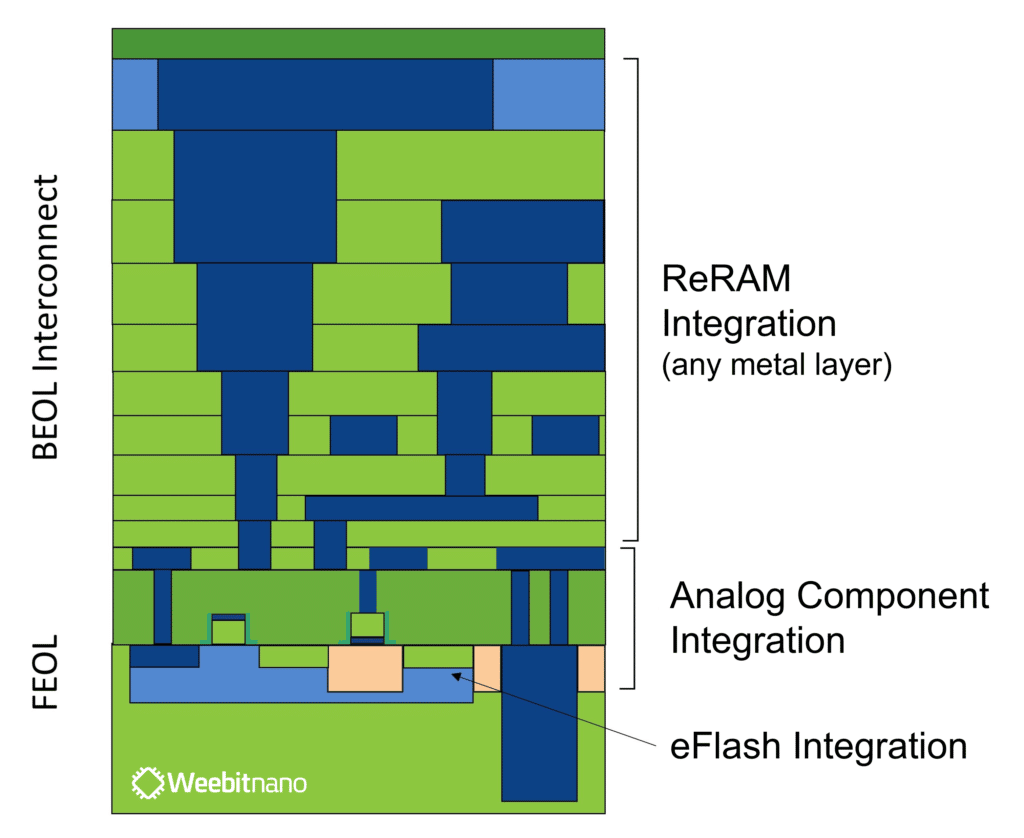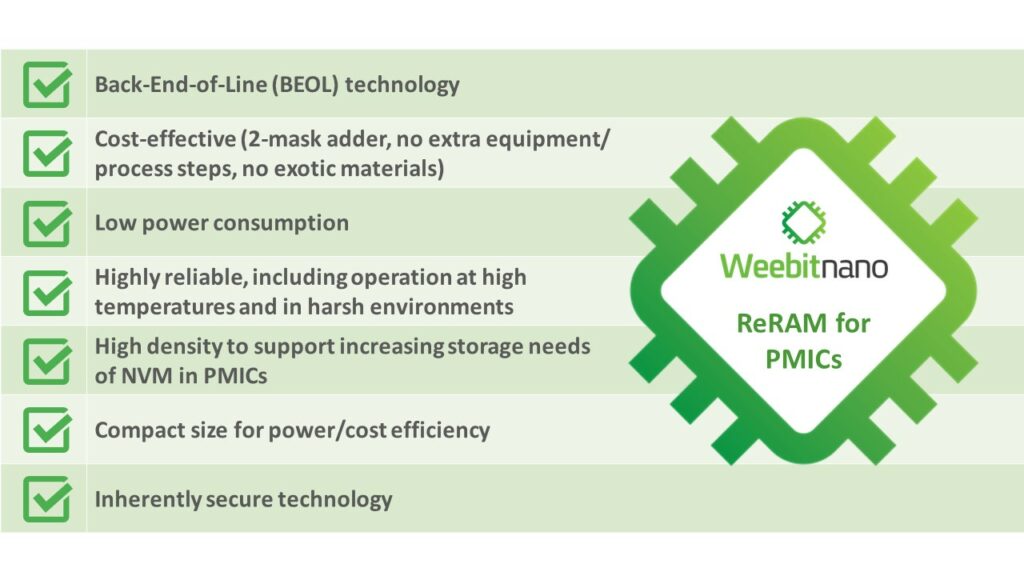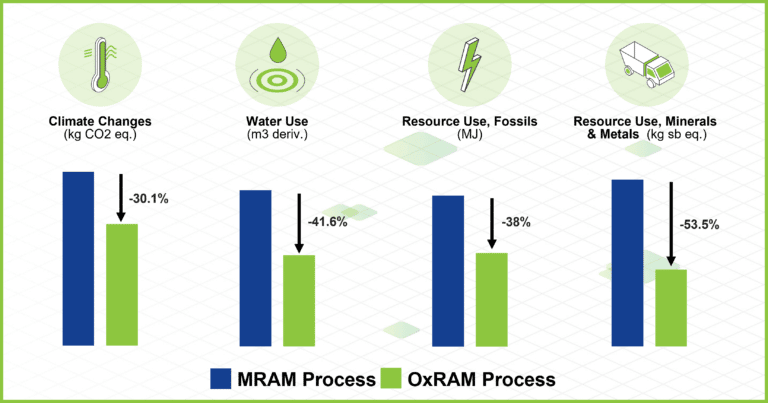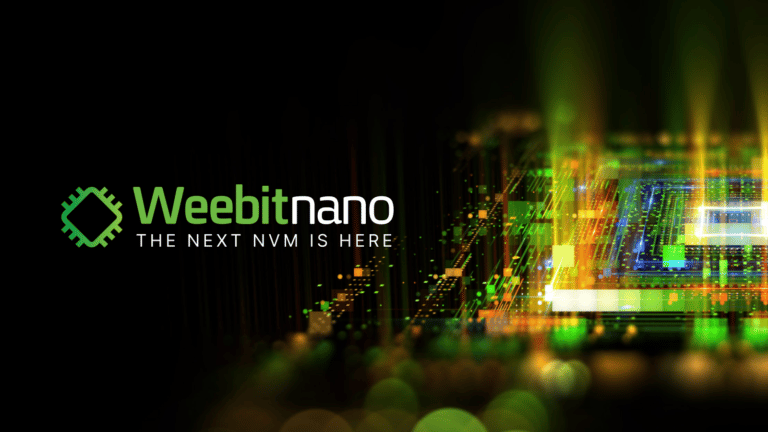As Weebit ReRAM continues towards production, we’ve decided now would be a good time to dig into some of the applications where we think our technology will first have an impact. One of these is power management integrated circuits (PMICs).
What is a PMIC?
One of the first things to know about a PMIC is how to say it. You can say each letter separately, or you can call it a “P-mick”. At only two syllables, it’s easier to say, and if you’re reading this article aloud to your colleagues, they’ll be very impressed by your knowledge.
PMICs are integrated circuits (ICs) that regulate and control the power in an electronic system and often incorporate multiple power management functions in one chip. For mobile and other battery-operated devices like wearables, hearables, sensors, and IoT devices, PMICs can help extend battery life, decreasing battery size to achieve the smallest possible form factor. In high-performance, computationally intensive platforms, PMICs are used to maximize performance per watt while increasing system efficiency.

A PMIC is responsible for controlling the flow and direction of electrical power within a device
PMICs are ubiquitous – they are used in just about every electronic system. At the most basic level, the PMIC controls the flow and direction of electrical power within a system. It sets the voltage levels (e.g., 3.3V, 5V, etc.) for each of the chips in a system, including CPUs, digital-to-analog converters (DACs), analog to digital converters (ADCs), and input/output (I/O) devices. Because voltage often varies between these components, many products use multiple voltages internally, and the PMIC makes sure the correct voltage is supplied to each one. The PMIC also acts as a conduit from the external power source – such as a battery or wall outlet – to the various components. Because of the combination of functionality that is required in a PMIC, a BCD (Bipolar-CMOS-DMOS) technology is often used. This single process makes it possible to integrate analog components (bipolar), digital components (CMOS) and high-voltage transistors (DMOS) on the same die. This is a complex technology that provides advantages for PMICs and a large set of analog and power components to the designer.
All this means that a PMIC’s job is more challenging in more complex products. Today, PMICs for complex systems have pre-programmed and adjustable functions to address the many disparate requirements they may face, and they are often field upgradeable as well.
A Growing Market
According to a 2021 report from Yole, the PMIC market will grow to more than US$25.6 billion by 2026, with mobile/consumer representing the largest segment. Multi-channel PMICs – those that need various voltages to power various loads – are dominant in these markets.
The same report predicts automotive and industrial applications will grow most quickly during that time. In automotive, this is driven by adoption of multi-channel PMICs widely used in advanced driver assistance systems (ADAS), as well as electric vehicles where PMICs manage the power flow through the EV battery.
There are also opportunities for highly integrated PMICs in other segments such as industrial, telecom, and medical applications.
NVM in PMICs
Power management as a function has been used for decades. Up until the mid-1990s, the primary goal was to trim voltages to fit product requirements, and this was handled as a simple analog function. In the mid-1990s, as electronic complexity increased, PMICs began to manage this function using very simple EEPROM, a basic type of read-only Non-Volatile Memory (NVM) to store analog calibration and trimming data. One-Time-Programmable (OTP) NVM was also used for this function, but since trimming often requires iterative voltage adjustments, multiple banks of NVM were needed when using OTP.
Starting in the early 2000s, as companies started integrating more and more digital functionality into one chip (a System-on-a-Chip or SoC) to meet performance, cost and power consumption goals, the function of the NVM inside of PMICs began to evolve and it continues to do so today. While still used for trimming voltages, in today’s highly integrated SoCs, embedded NVM is a critical block within the PMIC, used to store controller code and configuration data, as well as unique IDs.
Some PMICs today also require integration of a microcontroller (MCU) for added intelligence, including smart sensing and measurement in ultra-low power IoT products. These highly integrated systems not only need to store data and boot code, but must also run firmware updates, requiring high-performance, low-power NVM.
As NVM plays an increasingly critical role in these chips, it has moved from storing hundreds of bits to thousands of bits to tens of thousands of bits – potentially even a million bits.
Of course, not every PMIC needs this level of complexity. Some systems need only very simple voltage regulation, and simple PMICs with small NVM can do this. This is why NVM for PMICs can range from very simple EEPROM or OTP NVM for small, simple requirements; to Multiple-Time Programmable (MTP) for a small programmable/reconfigurable NVM; to embedded flash for more robust needs. There are power, area, performance and cost tradeoffs which designers must consider alongside power management requirements.
Embedded Flash in PMICs
When it became apparent in the early 2000s that a more robust NVM solution was needed for a growing number of PMICs, embedded flash was the only available option, so that’s the way the industry moved. Unfortunately, the addition of flash introduced a great deal of complexity and expense, starting with the addition of between seven and 11 extra masks into an already complex manufacturing process.
Another complication is that embedded flash must be integrated in the Front End of Line (FEOL) of the manufacturing process where other analog and power components are also integrated. Because the BCD process integrates a variety of different components on a single die, it requires careful balancing of the different design needs of each device type.
At the same time, Flash requires careful integration to make sure it works reliably within a design – often based on past experience and best practices. To accommodate it, companies must make technology design trade-offs that sometimes compromise the other analog components in the FEOL. In this way, flash plays an outsized role in driving the integration strategy of the whole chip. This is obviously not ideal since the compromises designers must make to accommodate flash can lead to overall degraded performance, larger size, and higher cost.
Flash has other limitations including a lack of robustness in harsh environments, which often requires building costly redundancy into the design. Importantly, the integration cost of embedded flash increases with each process shrink, an obvious challenge as companies move to more advanced process geometries. All this means that the industry is looking for new NVM solutions.
Emerging Memories for PMICs
When considering alternatives, the first consideration is whether an NVM is integrated in the back-end-of-line (BEOL), where no compromises are needed with other analog components. Using a BEOL NVM allows full optimization of analog components, and it simplifies adoption into new fabs (it can be adopted once for a geometry and it will work with all the different variants, unlike flash which must be adapted to each variant). A BEOL memory is the best alternative to embedded flash for PMICs, but it must be small and cost-effective.

Weebit ReRAM is a Back-End-of-Line (BEOL) technology, enabling full optimization of analog components, and simplifying adoption into new fabs
As a BEOL NVM technology, Ferroelectric RAM (FRAM) is one option that companies can consider. However, FRAM is unable to handle the high temperatures needed in PMICs (up to 150 degrees Celsius). It also requires exotic materials and new fab equipment – neither of which makes sense for an analog chip like a PMIC. Another option is Magnetoresistive RAM (MRAM). MRAM is also a BEOL technology and, in most cases, it can handle high temperatures. However, MRAM is complex and expensive from a capital expenditure as well as manufacturing standpoint, requiring expensive additional tools and masks, which is not a good fit for the analog market.
The answer? Weebit ReRAM. As a small and cost-effective BEOL technology, it checks all the boxes for NVM in PMICs.

Weebit ReRAM checks all the boxes for NVM in PMICs
Toward Net Zero
The low power consumption of Weebit ReRAM is an important advantage for PMICs, especially as societies across the world look for ways to decrease their carbon footprints. PMICs can keep power consumption and dissipation in electronic systems as low as possible – both active (when it’s on) and leakage (when it’s off). With PMICs designed from top to bottom for high efficiency – including ultra-low-power NVM, it’s possible to have a real impact on this critical issue.
Weebit and our R&D partner CEA-Leti are currently conducting an environmental initiative that will analyze the environmental impact of Weebit’s ReRAM compared to other NVM technologies.
With its unique combination of advantages, Weebit ReRAM is the logical alternative to embedded flash for the next generation of PMICs.












